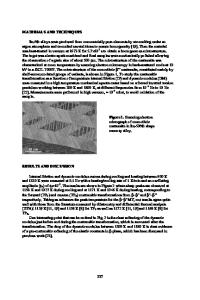Relaxation Processes at High Temperature in TiAl-Nb-Mo Intermetallics
- PDF / 271,024 Bytes
- 6 Pages / 432 x 648 pts Page_size
- 95 Downloads / 367 Views
Relaxation Processes at High Temperature in TiAl-Nb-Mo Intermetallics Pablo Simas1, Thomas Schmoelzer2, Svea Mayer2, Maria L. Nó3, Helmut Clemens2 and Jose San Juan1 1
Física Materia Condensada, Facultad de Ciencia y Tecnología, Universidad del País Vasco, Apdo. 644, 48080 Bilbao, Spain. 2 Department of Physical Metallurgy and Materials Testing, Montanuniversitaet Leoben, FranzJosef-Str. 18, A-8700 Leoben, Austria. 3 Física Aplicada II, Facultad de Ciencia y Tecnología, Universidad del País Vasco, Apdo. 644, 48080 Bilbao, Spain. ABSTRACT In the last decades there was a growing interest in developing new light-weight intermetallic alloys, which are able to substitute the heavy superalloys at a certain temperature range. At present a new Ti-Al-Nb-Mo family, called TNM™ alloys, is being optimized to fulfill the challenging requirements. The aim of the present work was to study the microscopic mechanisms of defect mobility at high temperature in TNM alloys in order to contribute to the understanding of their influence on the mechanical properties and hence to promote the further optimization of these alloys. Mechanical spectroscopy has been used to study the internal friction and the dynamic modulus up to 1460 K of a TNM alloy under different thermal treatments. These measurements allow to follow the microstructural evolution during in-situ thermal treatments. A relaxation process has been observed at about 1050 K and was characterized as a function of temperature and frequency in order to obtain the activation parameters of the responsible mechanism. In particular, the activation enthalpy has been determined to be H= 3 eV. The results are discussed and an atomic mechanism is proposed to explain the observed relaxation process. INTRODUCTION Among the different families of intermetallics, γ-TiAl based alloys were soon envisioned as good candidates for advanced automotive and jet engines [1-3]. In the eighties of the last century intensive work on the fundamental aspects of the first generation of binary TiAl alloys was performed, followed by the development of a second generation of more complex ternary alloys Ti-(45-48)Al-(1-3)Cr-(2-5)Nb,Ta,Mo (at%). During the last 15 years a third generation with a high niobium content Ti-45Al-(5-10)Nb was developed to improve both room temperature ductility and high temperature creep resistance [4,5]. Parallel, basic thermal treatment parameters were defined to adjust the microstructure from fully lamellar to duplex and near-gamma [5]. In spite of all this effort, they were not able to fulfill an important requirement for an industrial scale development, namely hot-working at reasonable costs. The challenge was to design an alloy fulfilling that particular requirement, leading to the development of a new type of TiAl alloy which contains both Nb and Mo in well balanced quantities (a so-called TNM alloy). The
41
basic strategy was to develop a β-stabilized γ-TiAl based alloy, which allows a near conventional processing and the adjustment of a creep-resistant microstructure suitabl
Data Loading...











